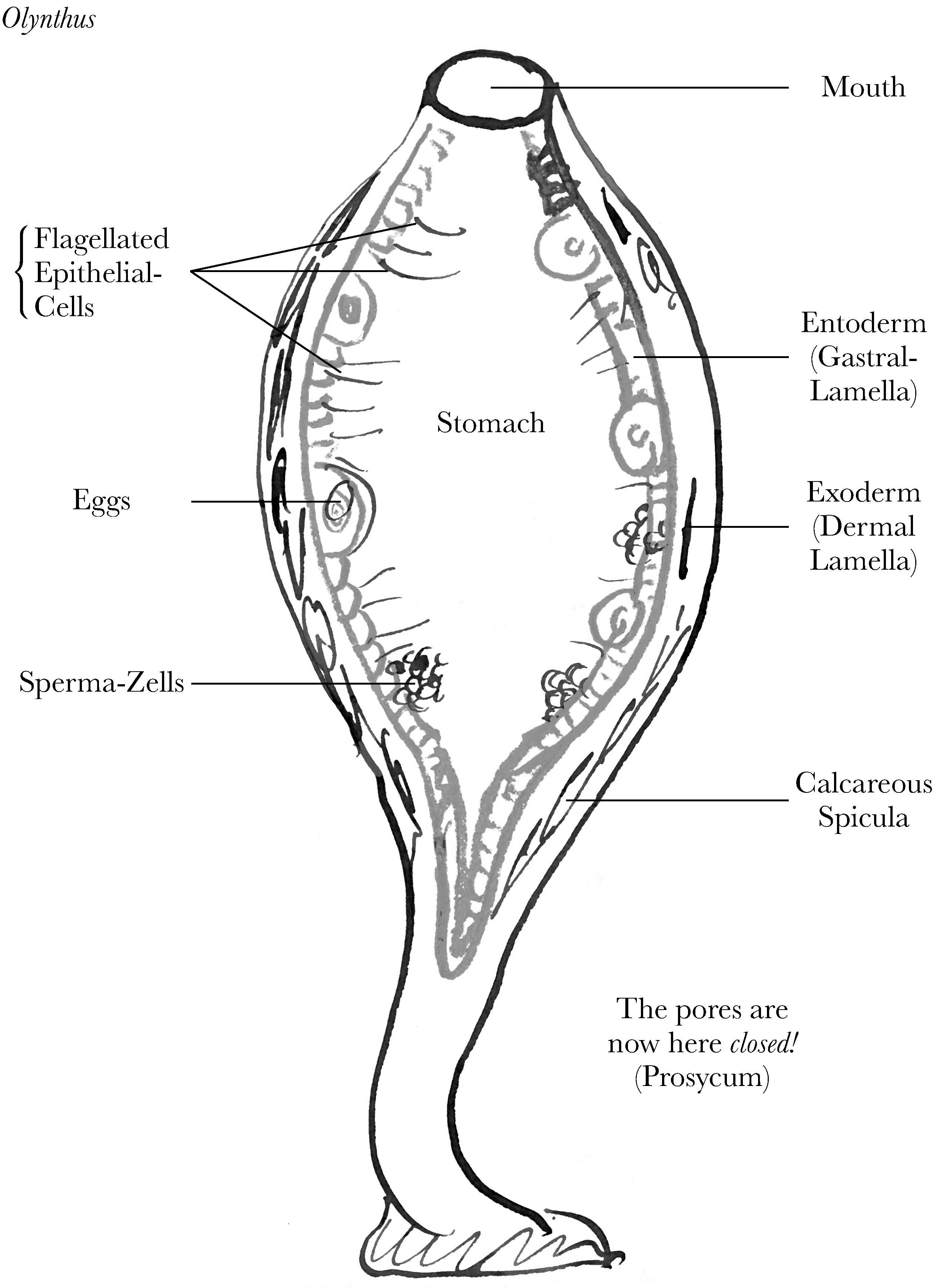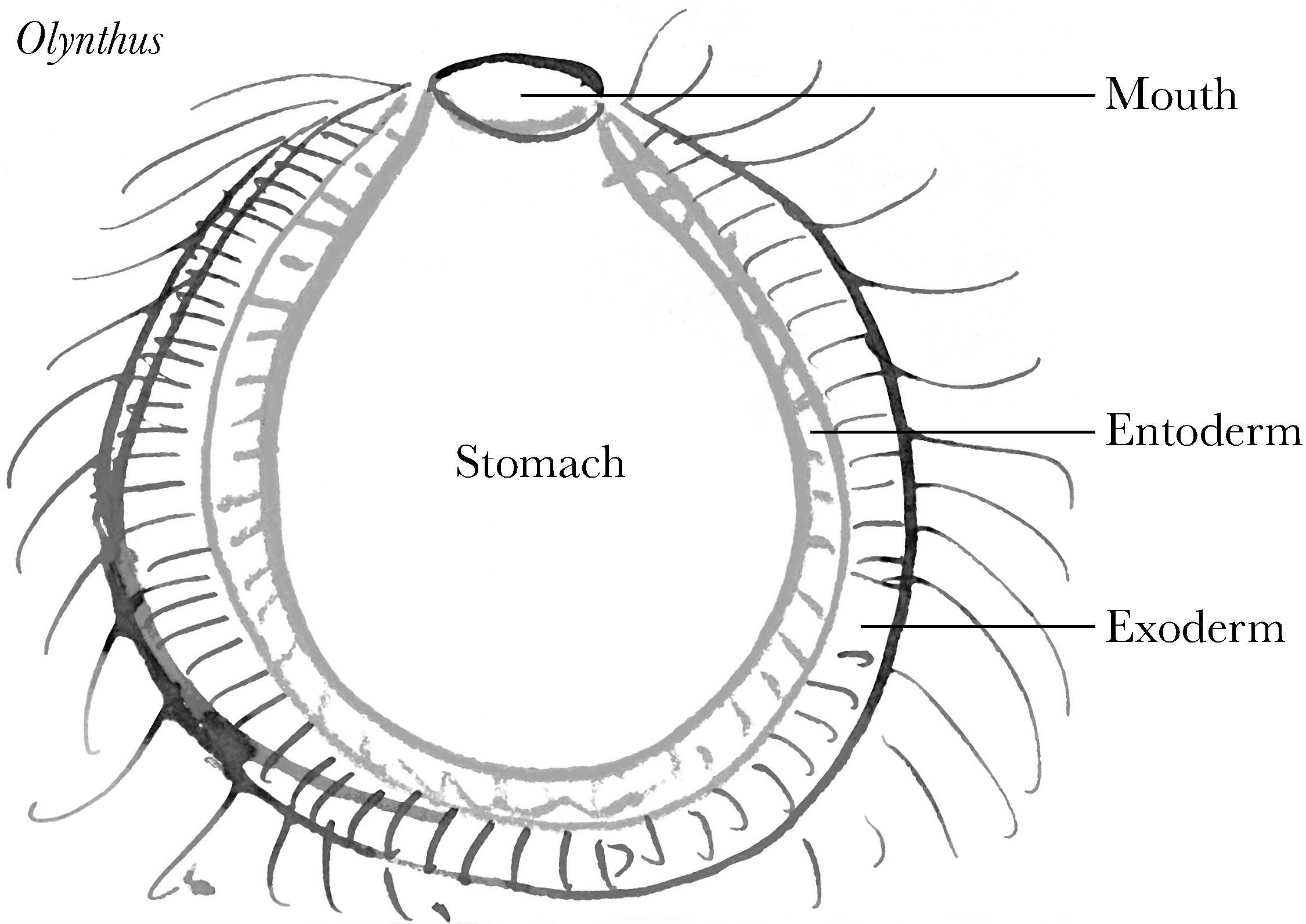From Ernst Haeckel1 10 December 1872
Jena
10 Decbr 72
Mein theurer hochverehrter Freund!
Verzeihen Sie, dass ich Ihnen erst heute für das gütigst übersandte Explr. Ihres sehr interessanten Werkes über “Expression of the emotions etc” meinen freundlichsten Dank sage.2 Ich war aber in den letzten Monaten völlig absorbirt von der Vollendung meiner “Monographie der Kalkschwämme” (Calcispongien oder Grantien).3 Um das Werk fertig zu machen noch in diesem Jahr, musste ich Tag und Nacht schreiben, und in den letzten Wochen täglich einen ganzen Druckbogen corrigiren. Eine schreckliche Arbeit, welche mich zu keiner Lectüre kommen liess. Ich habe daher Ihr Buch on “Expression” etc. nur erst flüchtig durchlesen können und hoffe jetzt, nach meiner Befreiung von den Spongien, es in ganzer Musse lesen zu können.
Meine Monographie der Kalk-Spongien (2 Bände Text und 1 Atlas mit 60 Tafeln) werden Sie in den nächsten Wochen direct von meinem Verleger erhalten, welchen ich beauftragt habe, Ihnen ein Exemplar zu schicken.4 Vorläufig sende ich Ihnen beifolgend die beiden letzten Bogen des ersten Bandes und das Titel-Blatt mit Vorrede.5 Ich hoffe, dass die generellen Resultate im 7 und 8 Capitel Sie interessiren werden, besonders das “biogenetische Grundgesetz, die generischen und spezifischen, connexiven und transitorischen Varietäten, und die “Ursachen der Formbildung” (p. 479, 481).6 In dem III Capitel (Morphologie) wird das Intercanal-System für Sie von Interesse sein (p. 275–290), im IV. Capitel die Parallele zwischen Ontogenie und Phylogenie des Olynthus (p. 347), im V. Capitel die Anpassung (p. 381–391), die sich hier ausgezeichnet verfolgen lässt, und die Vererbung (p. 399).7 Das Resultat für die generelle Zoologie ist insofern wichtig, als der Species-Begriff in gewöhnlichem Sinne bei den Spongien gar nicht zu fassen ist; die Variabilität übersteigt alle Grenzen. Ich musste daher im speciellen Theile (im II. Bande) 2 Systeme machen, ein natürliches und ein künstliches.8 Zur Vergleichung beider bitte ich Sie, die Formen von Ascetta primordialis auf Taf. 2 anzusehen, ferner Ascaltis Darwinii (Taf. 10, Fig. 3) mit ihren generischen und specifischen Varietäten (A. Erasmi und A. Caroli), ferner Leucetta primiginenia (Taf. 21) und Sycandra compressa (Taf. 57).9 Die Polymorphose dieser und anderer Arten ist für die Descendenz-Theorie höchst lehrreich
Von besonderer Wichtigkeit scheint mir der Olynthus zu sein, die einfachste Form der Kalkschwämme, weil dieser sich unmittelbar aus der Gastrula ableiten lässt, die als Larve oder Embryonal-Form auch bei den höheren Thierstämmen vorkommt. (p. 466, 467). Ich glaube, dass dadurch der Stammbaum des Thierreichs auf S. 465, und besonders die Descendenz aller Thiere (exclus. Protozoen) von der Gastraea an Sicherheit ausserordentlich gewinnt. Die beiden Lamellen, aus denen die Magenwand des Olynthus besteht, sind identisch mit den beiden Keimblättern der höheren Thiere. Die primordiale Phylogenie der höheren Thiere wird da⟨d⟩ur⟨ch⟩ ausserordentlich klar; zumal dieselbe Gastrula auch bei Amphioxus und den Ascidien sich findet.10
Die Bedeutung der Calcispongien scheint mir vorzüglich darin zu gipfeln, dass sie einerseit eng an die Polypen (Hydra, Cordylophora) sich anschliessen, anderseits viel einfacher als die übrigen Spongien in dem Ascon-Typus sich offenbaren. Die Homologie des Olynthus und der Hydra erscheint mir unzweifelhaft, und somit auch der morphologische Werth ihrer inneren Höhle als Darmhöhle11 Durch die Gastrula entfernen sie sich zugleich weit von den Protozoen.12 Wenn Sie die Gastrula der Calcispongien (Atlas Taf. 13, Taf. 30, Taf. 44) vergleichen mit der entsprechenden Larvenform der Würmer und Echinodermen, der Ascidien und des Amphioxus (wie ich sie z. B. auf Taf. X, Fig. A4, B4 in meiner “natürlichen Schöpfungsgeschichte13 abgebildet habe) so werden Sie die morphologische Identität zugestehen müssen.
Ich sende Ihnen noch ein zweites Exemplar der beiden letzten Capitel, mit der Bitte, es an Sir John Lubbock gelangen zu lassen, dessen Adresse ich nicht kenne. Wenn Sie Sir Lubbock sprechen sollten, bitte ich ihm zu sagen, dass seine “Prehistoric Times jetzt in das Deutsche übersetzt werden. Ich habe Virchow gebeten, eine Vorrede dazu zu schreiben.14
Haben Sie die englische Übersetzung meiner Schöpfungsgeschichte schon erhalten? Oder ist sie noch nicht fertig?15
Ich hoffe, mein theurer Freund, dass Sie mit Ihrer Gesundheit zufrieden sind!
Indem ich meinen Dank für Übersendung Ihres Buchs wiederhole, bleibe ich mit der bekannten Verehrung Ihr von ganzem Herzen | ergebener | Ernst Haeckel


Grosses Aufsehen in Germany erregt jetzt ein Buch unseres geistvollen Theologen David Strauss: “Alter und neuer Glaube”. Der Verfasser des “Lebens Jesu” zeigt sich hier als überzeugter Darwinist, und entwickelt eine philosophische Religion auf dem Boden des Darwinismus!!16
Es geht vorwärts!!
Footnotes
Bibliography
Correspondence: The correspondence of Charles Darwin. Edited by Frederick Burkhardt et al. 29 vols to date. Cambridge: Cambridge University Press. 1985–.
Di Gregorio, Mario A. 2005. From here to eternity: Ernst Haeckel and scientific faith. Göttingen: Vandenhoeck & Ruprecht.
Expression: The expression of the emotions in man and animals. By Charles Darwin. London: John Murray. 1872.
Haeckel, Ernst. 1866. Generelle Morphologie der Organismen. Allgemeine Grundzüge der organischen Formen-Wissenschaft, mechanisch begründet durch die von Charles Darwin reformirte Descendenz-Theorie. 2 vols. Berlin: Georg Reimer.
Marginalia: Charles Darwin’s marginalia. Edited by Mario A. Di Gregorio with the assistance of Nicholas W. Gill. Vol. 1. New York and London: Garland Publishing. 1990.
Strauss, David Friedrich. 1836. Das Leben Jesu: kritisch bearbeitet von Dr. D. F. Strauss, gepruft für Theologen und Nichttheologen von Wilhelm Hoffmann. Stuttgart: P. Balz’sche Buchhandlung.
Strauss, David Friedrich. 1872. Der alte und der neue Glaube: ein Bekenntniss. Leipzig: S. Hirzel.
Weikart, Richard. 1993. The origins of social Darwinism in Germany, 1859–1895. Journal of the History of Ideas 54: 469–88.
Translation
From Ernst Haeckel1 10 December 1872
Jena
10 Decbr 72
My dear most honoured friend!
Forgive me for only today expressing my kindest thanks for the copy of your very interesting work on “Expression of the emotions etc”, which you so obligingly sent me.2 Over the past months, I was completely absorbed by the task of completing my “Monographie der Kalkschwämme” (Calcispongiae or Grantia).3 In order to complete the work in this year, I had to write day and night, and in the last weeks I had to correct an entire set of proofs daily. An awful labour, which prevented me from doing any reading at all. This is why I was able only to skim through your book on “Expression”, and now, liberated from the Spongiae, I hope to be able to read it at leisure.
You will receive my monograph on the calcareous sponges (2 volumes text and 1 atlas with 60 plates) within the next few weeks, directly from my publisher, whom I have instructed to send you a copy.4 For the time being I am sending you the last two chapters of the first volume and the title page of the preface.5 I hope that you will be interested in the general conclusions of ch. 7 and 8, in particular “biogenetische Grundgesetz, die generischen und spezifischen, connexiven und transitorischen Varietäten, and the “Ursachen der Formbildung”(p. 479, 481).6 Of interest to you in chapter III (morphology) is the intercanal-system (p. 275–290), in chapter IV. the parallel between ontogeny and phylogeny of the Olynthus (p. 347), in chapter V. adaptation (p. 381–391), which can be followed here most admirably, and heredity (p. 399).7 The result for general zoology is important insofar as the concept of species in the usual sense is not at all applicable to sponges; their variability exceeds all limits. Thus, in the special part (in volume II), I had to create 2 systems, a natural and an artificial one.8 For a comparison between the two I ask you to inspect the forms of Ascetta primordialis in table 2, also Ascaltis Darwinii (table 10, fig. 3) with their generic and specific varieties (A. Erasmi and A. Caroli), and furthermore Leucetta primiginenia (tab. 21) and Sycandra compressa (tab. 57).9 The polymorphosis of this and of other kinds is most instructive for the theory of descent.
Olynthus seems to me to be of particular importance, the simplest from of calcareous sponge, because it can be traced back directly to the Gastrula, which also occurs as the larval or embryonic form of higher animals. (p. 466, 467). I believe that through this, the phylogenetic tree of the animal kingdom on p. 465, and especially the descent of all animals (excepting Protozoa) from the Gastraea gain tremendously in certainty. The two lamellae that form the stomach wall of the Olynthus are indentical with the two germ layers of higher animals. With this, the primordial phylogeny of higher animals becomes extremely clear; for the same gastrula can be found in Amphioxus and in the Ascidians.10
To my mind, the significance of the Calcispongiae seems to culminate chiefly in that on the one hand they are closely related to Polyps (Hydra, Cordylophora), and that on the other hand they are evidently far more simple than the lowest sponges of the Ascon-type. The homology of Olynthus and Hydra seems to me indubitable, and consequently the morphological significance of their inner cavity is that of an intestinal cavity11 Also, because of the Gastrula, the Spongi are far removed from the Protozoa.12 If you compare the Gastrula of the Calcispongi (atlas table 13, table 30, table 44) with the corresponding larval form of worms and echinoderms, of Ascidians and of Amphioxus (as I have reproduced them e.g. on table X. fig. A4, B4 in my “natürliche Schöpfungsgeschichte),13 you must concede their morphological identity.
I am sending you yet another copy of the two last chapters, with the request that you may arrange for the same to get to Sir John Lubbock, whose address I do not have. Should you talk to Sir Lubbock, please tell him that his “prehistoric times are now being translated into German. I asked Virchow to write an introduction.14
Have you already received the English translation of my Schöpfungsgeschichte? Or is it not ready yet?15
My dear friend, I hope you are content with your health!
Thanking you again for sending me your book, I remain with the usual respect your | wholeheartedly devoted | Ernst Haeckel


A great sensation in Germany is now being created by a book by our brilliant theologian David Strauss: “Alte und neue Glaube”. The author of “Leben Jesu” reveals himself here as a convinced Darwinist, and develops a philosophical religion on the basis of Darwinism!!16
We are making progress!!
Footnotes
Bibliography
Correspondence: The correspondence of Charles Darwin. Edited by Frederick Burkhardt et al. 29 vols to date. Cambridge: Cambridge University Press. 1985–.
Di Gregorio, Mario A. 2005. From here to eternity: Ernst Haeckel and scientific faith. Göttingen: Vandenhoeck & Ruprecht.
Expression: The expression of the emotions in man and animals. By Charles Darwin. London: John Murray. 1872.
Haeckel, Ernst. 1866. Generelle Morphologie der Organismen. Allgemeine Grundzüge der organischen Formen-Wissenschaft, mechanisch begründet durch die von Charles Darwin reformirte Descendenz-Theorie. 2 vols. Berlin: Georg Reimer.
Marginalia: Charles Darwin’s marginalia. Edited by Mario A. Di Gregorio with the assistance of Nicholas W. Gill. Vol. 1. New York and London: Garland Publishing. 1990.
Strauss, David Friedrich. 1836. Das Leben Jesu: kritisch bearbeitet von Dr. D. F. Strauss, gepruft für Theologen und Nichttheologen von Wilhelm Hoffmann. Stuttgart: P. Balz’sche Buchhandlung.
Strauss, David Friedrich. 1872. Der alte und der neue Glaube: ein Bekenntniss. Leipzig: S. Hirzel.
Weikart, Richard. 1993. The origins of social Darwinism in Germany, 1859–1895. Journal of the History of Ideas 54: 469–88.
Summary
Thanks CD for Expression.
Describes work on Die Kalkschwämme and its principal conclusions.
The application of biogenetic law.
Notes variability among calcareous sponges.
Gastrula-like "Gastraea" as ancestor of multicellular animals.
Posits homology between Hydra, Olynthus of calcareous sponges, and initial germ layers of higher animals.
Comments on Lubbock’s Prehistoric times [1865]
and on David Strauss’s Der alte und der neue Glaube [1872].
Letter details
- Letter no.
- DCP-LETT-8669
- From
- Ernst Philipp August (Ernst) Haeckel
- To
- Charles Robert Darwin
- Sent from
- Jena
- Source of text
- DAR 166: 34, 59
- Physical description
- ALS 8pp (German)
Please cite as
Darwin Correspondence Project, “Letter no. 8669,” accessed on 18 April 2024, https://www.darwinproject.ac.uk/letter/?docId=letters/DCP-LETT-8669.xml
Also published in The Correspondence of Charles Darwin, vol. 20


